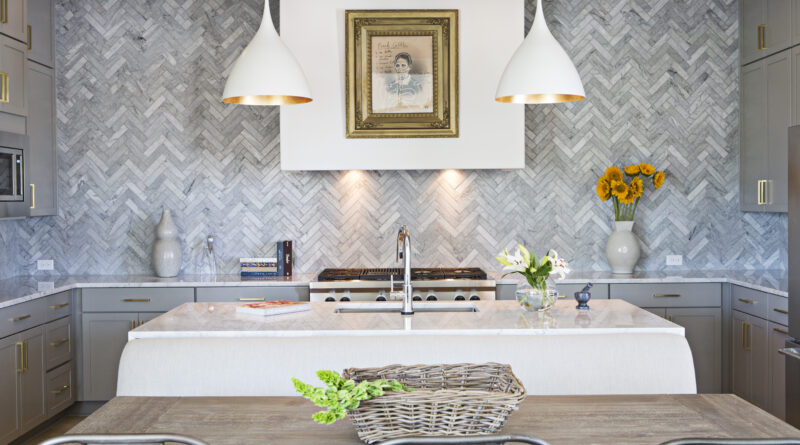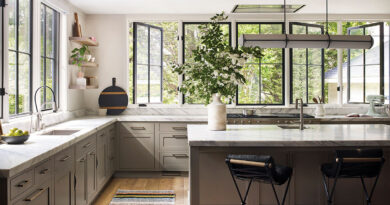Principles to Designing Healthier Living Spaces
A well-designed home that emphasizes occupant health and comfort while maximizing the use of sustainable materials is key to buyers today
By Jillian Pritchard Cooke
Flexible spaces that continually adapt to changing conditions are at the core of healthier interior living spaces. Whether the space adapts to a first-time homebuyer, a young couple that likes to entertain or a growing family, the successful evolution of living spaces is paramount. A well-designed, flexible home should expand and contract with the changing needs of the family, including boomerang kids, empty-nesters and the accommodation of those aging in place. Initiating different layouts with modular furniture components and adaptability over time is key.
Comfort in the home is often thought of as the ability to coordinate pleasing décor, when, in fact, it is the combination of the aesthetic presentation of the occupant’s personal objects within a high-performing building envelope. Occupants are happiest when the living environment maintains a comfortable temperature, the proper humidity level and excellent indoor air quality. Also, comfortable living spaces that balance aesthetics with function should ensure a clutter-free environment by designing adequate closets and storage. The ability to breathe easily and feel stress-free contributes to healthier outcomes from a mental and physical perspective.
When making interior envelope selections, reducing toxins during the specification process is vital. Materials made with heavy metals, toxic chemicals and high levels of VOCs can cause headaches, irritate eyes, nose and throat and damage the central nervous system, kidneys and liver. The risk is not just to the contractor and design professionals during the build; off-gassing continues after commissioning – often for months and sometimes years after the home is complete. Consulting safety data sheets and third-party certification programs help inform responsible choices and reduce harmful toxins.
Making sure natural light is used to accent architectural details and warm the interior is fundamental to healthier interior spaces. Access to natural light can influence a family’s state of mind. Natural light and the science of circadian rhythms can enhance moods and increase cognitive function, along with quality of sleep.
Natural and sustainable soft goods, including upholstered walls, sofas, chairs, benches, ottomans, banquettes, window treatments, accent pillows, area rugs, mattresses and bedding, contribute to noise reduction and the aesthetics of a well-appointed home. The proper selection of a mattress contributes to a healthier home. An uncomfortable mattress can affect sleep patterns and brain function and raise the risk of chronic health problems. Mattresses made of a combination of 100% organic cotton and formaldehyde-free latex are recommended by orthopedic specialists and chiropractors. Additionally, sustainable, eco-friendly upholstery fillers made of down, wool and cotton are best. Natural, uncoated wool, cotton, hemp and linen, just to name a few, are perfect for window treatments, upholstery, slip covering and area rugs.
Defining spaces by understanding the occupant’s lifestyle and priorities from a budget point of view at the beginning of the project is essential. If the homebuyer’s priority is culinary creativity, a substantial amount of the kitchen budget should be allocated to the kitchen layout, low-maintenance finishes, durable cabinets and the newest, high-performance appliances. Working kitchens should include intuitive technologies and proper ventilation strategies, such as an exterior-vented range hood. Water purification is achieved through proper filtration, whether built into the refrigerator, dedicated at the faucet or whole-home reverse osmosis. Minimizing waste through composting is a feature in cutting-edge kitchen design.
Another key to healthier home design is creating an oasis at home. Make sure bathroom specifications include a shower large enough for stretching and multiple sprayers for muscle relaxation. Consider a soaking or air-jet tub, a state-of-the-art bidet, back-lit mirrors, heated floors and relaxing music with Bluetooth capabilities. These features add to the at-home spa experience.
Low-maintenance homes reduce stress. Specifying materials that are resilient, high-performing and regenerative can reduce maintenance costs and help reduce callbacks for products under warranty.
Biophilic design is on the rise and can be realized through artwork, photography and natural living walls. Strategically located plants, case goods made of fallen trees and live-edge designs support a natural approach to designing a healthier home.
Finally, to assist in creating healthier designs, look for these resources: Green Guard, Environmental Working Group, Sustainable Furnishings Council, Global Organic Textile Standard, Allergy Standard and Wellness Within Your Walls.
Jillian Pritchard Cooke is the founder of Wellness Within Your Walls education and certification.



